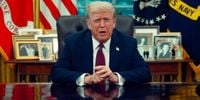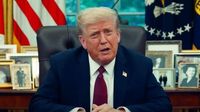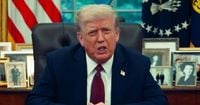The fatal shooting of conservative activist Charlie Kirk at Utah Valley University on September 10, 2025, sent shockwaves through American politics and beyond. But as the nation reeled from the loss, a new controversy erupted—not just over the political blame game, but over the very nature of President Donald Trump’s response. His Oval Office address, intended to unite or at least console, instead sparked a viral debate: was the video real, or was it manipulated using artificial intelligence?
Within hours of its release on the morning of September 11, 2025, the White House’s video statement—shared across official accounts and platforms like X and Truth Social—was dissected by millions. Viewers quickly noticed something odd: a peculiar glitch around the 18 to 19 second mark, where Trump’s right hand seemed to shrink, stretch, or even jump. The president, often photographed with a bruised right hand (sometimes caked in makeup), kept that hand mostly concealed beneath his left for the duration of the four-minute speech. For a public already primed to question the authenticity of digital content, this was more than enough to set social media ablaze.
As reported by The Daily Dot and echoed by The Irish Star and The Mirror, speculation ran wild. "Uhhhh, can some of the bigger accounts start talking about the Trump Oval Office address being AI? This is a pretty big deal," one user posted alongside a clip of the glitch. Another quipped, "Trump is covering his rotting right hand," while yet another wondered, "This looks like deep fake. What is going on... trump also covering THAT hand." Internet personality Matt Binder wrote, "This very much looks like an AI avatar of Trump delivering an official message for the president." The uncanny effect—barely moving hands, a static posture, and the glitch—fueled talk of deepfakes and digital avatars. Some even speculated that AI was used to conceal bruising or other blemishes on Trump’s hand.
Theories snowballed: Was the White House using AI to create or enhance the president’s address? Was Trump’s hand digitally altered to hide something, or was the entire video an elaborate deepfake? As social media posts promoting the AI theory racked up millions of views, the question became a trending topic, with users referencing not just the hand glitch but also background elements like trees in the Oval Office windows that seemed to "jump" at the same moment.
But as the online frenzy grew, experts stepped in to clarify the situation. Hany Farid, a University of California, Berkeley professor and co-founder of the deepfake detection company GetReal Security, analyzed the footage and found "no evidence that the audio or video is AI-generated." Farid explained, "Our audio analysis find(s) no evidence that the voice is AI-generated, and our video analysis finds no inconsistencies between Trump’s mouth movement and his voice as you might expect to see in a lip-sync or avatar deepfake." However, he did note "some localized video manipulation"—specifically at the 19-second mark where the glitch occurs.
Filmmaker and creative technologist Albert Bozesan agreed, telling Straight Arrow News that the distortion was likely caused by a "morph cut effect." He described it as "something video editors do to splice together two different takes. Usually it’s seamless, unless there’s a lot of movement between takes. It basically mistook one finger for another in this case." This technique, known as a morph cut, analyzes differences between two clips and generates new frames to fill the gap, smoothing over jump cuts but sometimes creating odd artifacts—especially if the subject moves their hands.
TikToker Brian Alldridge, whose video dissecting the glitch garnered over 374,000 views, echoed this assessment: "You’ve got two separate clips that are stitched together. What the software will do is analyze the difference between those clips and generate new frames to fill the gap." In short, the video was not AI-generated, but rather edited using a morph cut to blend two takes. This, some argued, was perhaps more concerning: why couldn’t the president deliver a short address in a single take? Others shrugged off the editing as standard practice in modern video production.
Still, the controversy didn’t stop at digital manipulation. The content of Trump’s remarks drew its own firestorm. Instead of a call for unity, as some commentators and past presidents might have offered in the wake of political violence, Trump’s speech was combative. He called Kirk a "martyr for truth," blamed the "radical left" for the shooting, and promised a crackdown on organizations he accused of fomenting violence. "For years, they have compared wonderful Americans like Charlie to Nazis and the world’s worst mass murderers and criminals," Trump declared. He cited a string of violent incidents, including the assassination attempt against himself in July 2024, the murder of UnitedHealthcare CEO Brian Thompson in December 2024, attacks on ICE agents, and the 2018 shooting of House Majority Leader Steve Scalise.
Yet critics were quick to point out what Trump left unsaid. As noted by The Daily Dot, he did not reference attacks on Democratic politicians, such as the fatal shooting of Minnesota state representative Melissa Hortman and her husband Mark in June, or the earlier shooting of state senator John Hoffman and his wife, Yvette. This selective condemnation, some argued, only deepened the nation’s divisions at a time when many hoped for healing words from the Oval Office.
The fallout from Kirk’s assassination and Trump’s response was felt far beyond Utah. Turning Point UK, a conservative group linked to Kirk, announced plans for a vigil in London’s Whitehall, echoing the sense of loss felt by Kirk’s supporters across the Atlantic. "It’s absolutely shocking, we’re heartbroken over here in the UK," the group’s chief executive Jack Ross told Sky News.
Meanwhile, the debate over digital authenticity is unlikely to fade anytime soon. As deepfake technology becomes more sophisticated and public trust in official communications erodes, even minor glitches—whether caused by AI, morph cuts, or simple editing mistakes—can trigger widespread suspicion. For now, experts agree that Trump’s Oval Office address was not an AI fabrication. But the episode has left many Americans wondering: in an era of political upheaval and digital wizardry, how can we be sure what we’re seeing is real?
In the end, the controversy over Trump’s video may say as much about the country’s fractured media landscape and collective anxiety as it does about the technology itself. The search for truth—whether about a tragic shooting or the authenticity of a presidential address—remains as urgent as ever.






